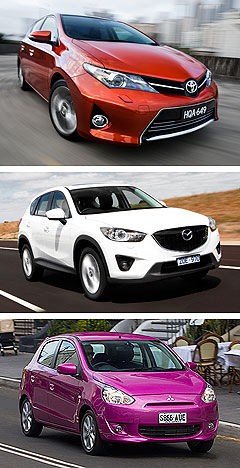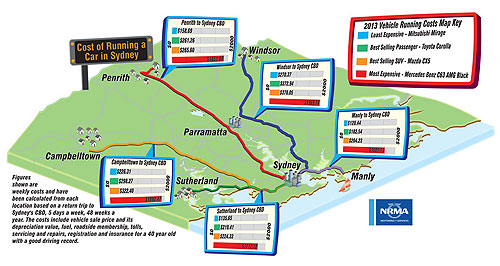News - Market Insight - Market Insight 2013Market Insight: Running costs put into perspectiveBlack belt: NRMA says Mercedes’ C63 AMG Black could cost around $95,000 a year to run from Sydney’s outer suburbs to the CBD, but most of this comes down to capital costs rather than daily expenses such as fuel. Huge discrepancy between vehicles in new NRMA study into Sydney commuting costs1 Oct 2013 By TERRY MARTIN THE NRMA’s latest study into vehicle running costs has provided an insight into the expenses involved in commuting to Sydney’s CBD from a variety of locations in the suburbs, with the sums varying wildly depending on the vehicle of choice. Running-cost surveys conducted by state motoring organisations are a useful tool for prospective vehicle buyers, throwing some rational evidence behind the purchase decision that typically brings together a wide variety of factors, both practical and emotional. In releasing its 2013 Running Costs Calculator this week, which like RACV earlier this year found the Mitsubishi Mirage to be the cheapest car to own and run, the NRMA revealed the results of some additional research it conducted into the cost of running a vehicle from various suburbs in Sydney. It analysed the operating costs of the Mirage alongside the vehicle found to be the most expensive in the broader survey, the Mercedes-Benz C63 AMG Black Series, plus the current best-selling model in the passenger vehicle and SUV categories – the Toyota Corolla and Mazda CX-5 respectively. The results are unsurprising in basic terms – yes, the exclusive $245,000 380kW 6.2-litre V8 Benz will cost more to run than the $12,990 57kW 1.2-litre three-cylinder Mitsu – but the discrepancy between the vehicles tested could give prospective owners pause for thought. Basing its study on a 40-year-old driver with a good driving record, and taking into consideration the vehicle sale price, its depreciation value, insurance, registration, roadside membership, fuel, tolls, servicing and repairs, the NRMA has found that the commute from Manly to the city in the Mirage will cost $120.44 a week. In comparison, the Mercedes is a staggering $1601.73 over the same route, while the Corolla (priced from just under $20,000) comes in at $182.54 and the CX-5 (from almost $28,000) is slightly higher at $204.23. Taking the longer commute from Windsor in Sydney’s far west (a round trip of about 115km) sees the Mirage’s weekly cost increase to $270.37, compared to $372.94 for the Corolla, $378.05 for the CX-5 – the difference between the two big-selling models evening out with the longer distance – and, wait for it, $1969.74 for the C63 Black. Spread that over a year (five days a week for 48 weeks) and the middle-aged Mirage driver is looking at spending just under $13,000 to commute from Windsor to the CBD – about the price he paid for the car – while in the Mercedes he is facing costs of more than $94,500.  From top: Toyota Corolla, Mazda CX-5 and Mitsubishi Mirage. From top: Toyota Corolla, Mazda CX-5 and Mitsubishi Mirage.It is commonly argued that the purchase price and cost of ownership is less of a concern for those in the market for a luxury car, but would the C63 owner in question here have ever imagined he’d be spending that much on the annual ‘commute’? This wild discrepancy has less to do with pure running costs such as fuel and servicing (although the latter is naturally higher on luxury cars) and everything to do with capital costs, the most significant of which is depreciation. The results from the NRMA’s overall running costs calculator (based on 15,000km travelled annually over a private ownership period of five years) show that the C63 Black’s average weekly ‘whole of life’ costs were $1549.31 a week, with out-of-pocket expenses (pure running costs) of around $150 and fuel bill of just $65.12. The Mirage, on the other hand, which was one of just three vehicles found to cost less than $100 a week to run (the others were the Holden Barina Spark and last year’s winner, the Suzuki Alto), came in at $93.29 for ‘whole of life’ operating costs per week, with out-of-pocket expenses $51.25 and fuel $22.56. So it is capital costs which are the main discrepancies between the vehicles the NRMA has found to be the cheapest and most expensive to own and operate. The overall study covers 1860 new vehicles and highlights some big differences between models in the same class, not just those in different categories such as those it analysed in the Sydney commute. “Families would have to find an extra $100 per week to own and run the Citroen C4 compared to the Proton Gen.2, despite both vehicles being in the ‘small car under $35,000’ class,” said the NRMA’s motoring research engineer David Carr. “The gaps between the cheapest and most expensive vehicles widen even further in some classes so it is important that families do their homework before buying a new vehicle.” The NRMA’s running cost calculator enables users to provide their own insurance rate as this varies depending on the vehicle location and driver’s age and record, while users can also input a custom petrol price depending on the blend they use. The motoring body also urges buyers to consider safety and environmental factors along with running costs when buying a new car. In the small-car class, for example, the Proton Persona and Gen.2 were again found to be less expensive to run than higher-selling cars, but the Hyundai Elantra was deemed the least expensive small car to run with a five-star ANCAP safety rating and electronic stability control as standard. Ditto for the soon-to-be discontinued Suzuki Jimny in the compact SUV class, which is cheap to run but lacks ESC and has fewer safety features than its main rivals.  Read more |
Click to shareMarket Insight articlesResearch Market Insight Motor industry news |


















Facebook Twitter Instagram